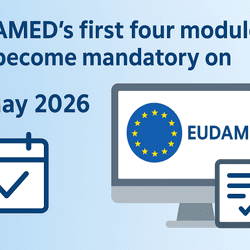
Navigating IVDR Performance Studies: Key Insights from MDCG 2025-5 Q&A
The European Medical Device Coordination Group (MDCG) has released its latest guidance, MDCG 2025-5, a comprehensive Questions & Answers document addressing performance studies for in vitro diagnostic medical devices (IVDs) under Regulation (EU) 2017/746 (IVDR). This document, published in June 2025, aims to clarify various aspects of performance studies, providing essential insights for manufacturers, sponsors, and other stakeholders in the IVD sector. This article summarizes the key takeaways from MDCG 2025-5, offering a concise overview for professionals navigating the complexities of IVDR compliance.
Understanding Performance Studies under IVDR
MDCG 2025-5 reiterates the IVDR's definition of a performance study as an undertaking to establish or confirm the analytical or clinical performance of an IVD. It clarifies that performance studies are distinct from clinical or laboratory methods, focusing solely on device performance. The guidance emphasizes that not all performance studies require fresh human specimens; data can be sourced from curated databases, registries, or previously collected patient material, and even contrived samples may be used for certain studies.
Analytical vs. Clinical Performance Studies
The document distinguishes between analytical and clinical performance studies:
- Analytical Performance Studies: These studies aim to establish or confirm an IVD's ability to detect or measure a specific analyte. This includes evaluating parameters such as analytical sensitivity, specificity, trueness (bias), and precision (repeatability and reproducibility).
- Clinical Performance Studies: These studies focus on establishing or confirming the clinical performance of an IVD, often involving human subjects and clinical outcomes.
Crucially, the MDCG 2025-5 clarifies that it is not always required to perform both analytical and clinical performance studies. The necessity depends on the specific IVD and its intended purpose.
Regulatory Pathways: Application and Notification
The Q&A document provides much-needed clarity on when performance studies require an application to or notification of the competent authority. Not all performance studies necessitate submission. Key considerations include:
- Application Requirements: Certain performance studies, particularly those involving surgically invasive sample-taking solely for the study's purpose (Article 58(1)(a)), interventional clinical performance studies (Article 58(1)(b)), or those involving invasive procedures (Article 58(1)(c) and Article 70(1)), require an application to the competent authority.
- Notification Requirements: Other studies, such as those involving companion diagnostics using only left-over samples (Article 58(2)), may only require notification. The document also addresses whether comparisons of CE-marked IVDs or studies initiated by academic researchers require notification or application.
Substantial Modifications
MDCG 2025-5 dedicates a section to substantial modifications, defining what constitutes a substantial change to a performance study and outlining the notification requirements. It clarifies the timeline for notifying Member States of such modifications and addresses whether changes to the device under study are considered substantial modifications or necessitate a new application.
Key Takeaways for Professionals
This MDCG guidance is a vital resource for anyone involved in IVD development and regulatory compliance. It underscores the importance of:
- Clear Intended Purpose: The responsibility for assigning the intended purpose of an IVD lies with the manufacturer, which dictates the scope of required performance studies.
- National Requirements: While the IVDR provides a framework, national requirements regarding ethics committee submissions must also be considered.
- Documentation: The document details the documentation required for both applications and notifications, including the performance evaluation plan and data supporting compliance with General Safety and Performance Requirements (GSPR).
- Timeline Considerations: Guidance is provided on when performance studies can commence, especially when multiple Member States are involved in specimen collection and analysis.
Conclusion
MDCG 2025-5 serves as an indispensable guide for navigating the intricate landscape of IVDR performance studies. By providing clear answers to frequently asked questions, it aims to streamline the regulatory process and ensure the continued safety and performance of IVDs within the European Union. Professionals in the IVD industry are strongly encouraged to review the full document for detailed guidance and to ensure ongoing compliance with the IVDR.
Reference
European Commission. (2025, June). MDCG MDCG 2025-5 - Questions & Answers regarding performance studies of in vitro diagnostic medical devices under regulation (EU) 2017/746. Retrieved from https://health.ec.europa.eu/latest-updates/mdcg-2025-5-questions-answers-regarding-performance-studies-vitro-diagnostic-medical-devices-under-2025-06-18_en
Latest news

MHRA Introduces New Device Registration Fee: What Manufacturers Need to Know
The UK’s Medicines and Healthcare products Regulatory Agency (MHRA) has updated its “DORS Fees Guidance 2.1”, introducing a new annual fee model for device registration.

EUDAMED’s first four modules become mandatory on 28 May 2026 - what this means for medical device manufacturers
The European Commission (EC) has formally declared that the first four modules of EUDAMED - the European Database on Medical Devices - will become mandatory as of 28 May 2026.

MedNet EC-REP GmbH to Exhibit at WHX 2026 in Dubai
MedNet EC-REP GmbH is excited to announce its participation in WHX 2026, taking place from February 9–12 in Dubai. As a trusted European Authorized Representative and compliance partner for global medical device manufacturers, we look forward to presenting our comprehensive regulatory services to an international audience.

Implications of the Update to the Borderline & Classification Manual under MDR and IVDR
On 12 September 2025, the European Commission published Version 4 of the Manual on Borderline and Classification under Regulations (EU) 2017/745 and 2017/746, developed by the Borderline and Classification Working Group (BCWG).

Regulatory Affairs Bulletin: Intended Purpose vs Intended Use under MDR & IVDR
European regulations EU 2017/745 (MDR) and EU 2017/746 (IVDR) require precise definitions in technical documentation, and the distinction (or overlap) between intended purpose and intended use remains a topic of operational significance.
-250x250.jpg&w=256&q=75)
MedNet EC-REP GmbH at MEDICA 2025 – Visit Us in Hall 3, Booth D43
MedNet EC-REP GmbH is pleased to announce that we will once again be exhibiting at MEDICA 2025 in Düsseldorf, the world’s leading trade fair for the medical technology industry.

EU eIFU Regulation Update Draft: What Medical Device Professionals Need to Know
The European Commission has introduced a significant amendment to Implementing Regulation (EU) 2021/2226, impacting how medical device manufacturers provide instructions for use (IFU).

Understanding the Interplay: MDR, IVDR, and the AI Act – Key Insights from MDCG 2025-6
Recently, the MDCG, in conjunction with the Joint Artificial Intelligence Board (AIB), released the MDCG 2025-6 FAQ document, offering essential clarifications on the interplay between the MDR, the IVDR, and the Artificial Intelligence Act (AIA).